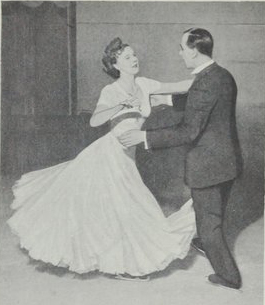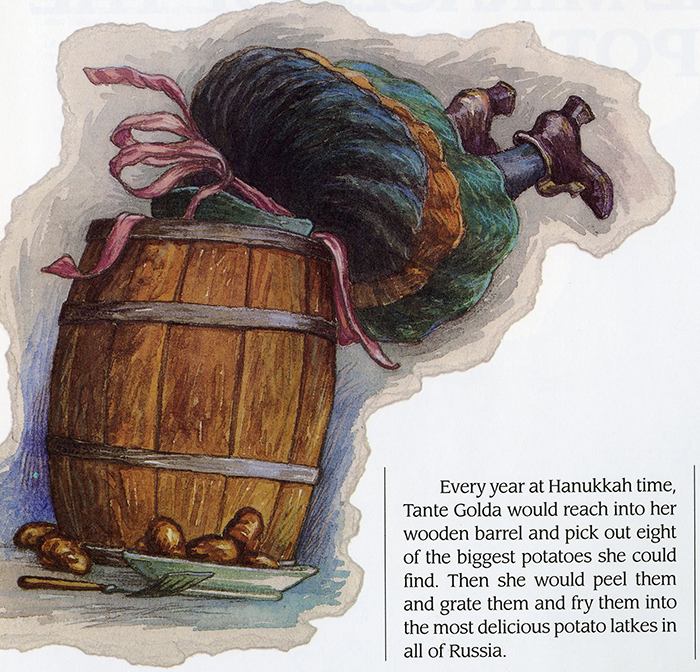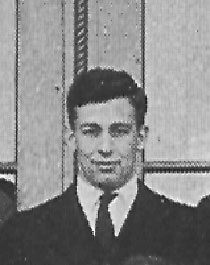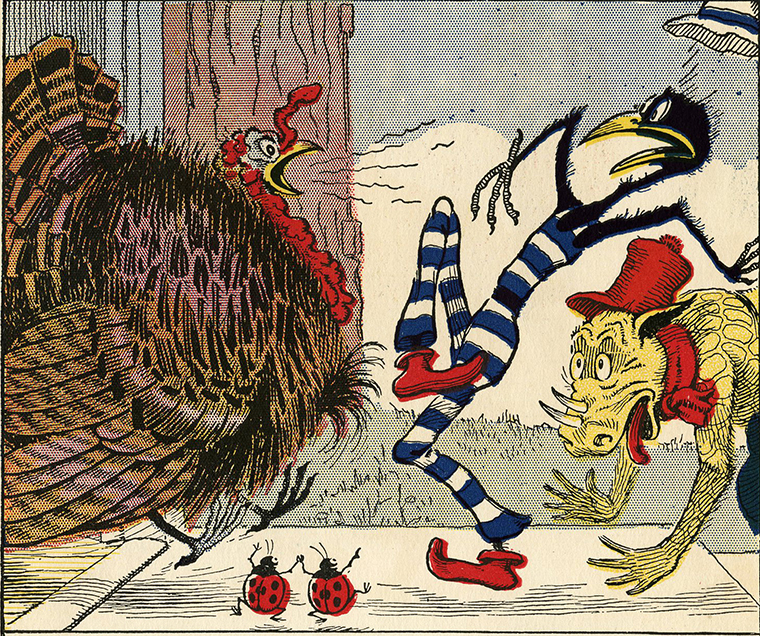It’s National Tango Day! Not in the U.S., though, but in Argentina. That’s as good an excuse as any to put up this photo of a couple dancing a tango on ice from the book “Dancing on Ice,” which you can find in our digital repository.
Happy Hannukah!
Here is a page from one of the many holiday books that you can find in the Northeast Children’s Literature Collection. The Miracle of the Potato Latkes: A Hanukkah Story, was written in 1994 by Malka Penn and illustrated by Giora Carmi. This page from the book is shown here courtesy of the author and illustrator.
Breaking news — 74th anniversary of the “day which will live in infamy”
About 1935, Andre Schenker, Associate Professor of History at UConn, began a regular broadcast series entitled “History in the Headlines” airing on WTIC. The series provided context and analysis of current events for the listening audience. In a reminiscence, Dr. Schenker’s son remembers attending a performance in Hartford on the evening of December 7, 1941, when an usher came to quietly speak with his father. Immediately leaving the performance, Dr. Schenker went on the air later to share the breaking news. The Japanese had bombed Pearl Harbor and the United States had declared war.
This and other broadcasts are available in the Schenker Papers held by Archives & Special Collections and online.
Happy Thanksgiving!
‘Slow Violence, Environmental Activism, and the Arts’: Teale Lecture happening today
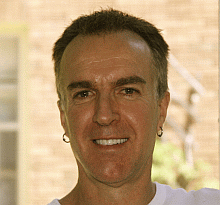 Today November 19 at 4:00pm in UConn’s Konover Auditorium, the Edwin Way Teale Lecture Series on Nature and the Environment presents Dr. Robert Nixon, The Thomas A. and Currie C. Barron Family Professor in Humanities and the Environment at Princeton University.
Today November 19 at 4:00pm in UConn’s Konover Auditorium, the Edwin Way Teale Lecture Series on Nature and the Environment presents Dr. Robert Nixon, The Thomas A. and Currie C. Barron Family Professor in Humanities and the Environment at Princeton University.
Dr. Nixon will explore the imaginative and political challenges posed by slow violence, by the incremental casualties that shadow our most pressing environmental crises. His talk will focus on activists and artists who are responding with an urgent creativity to the challenge of representing unspectacular environmental violence in a spectacle-obsessed age.
A frequent contributor to the New York Times, Dr. Nixon’s writing has also appeared in The New Yorker, Atlantic Monthly, London Review of Books, The Nation, The Guardian, and Outside. His book Slow Violence and the Environmentalism of the Poor has received several awards since its publication in 2011, including American Book Award, the 2012 Sprout prize from the International Studies Association for the best book in environmental studies, the 2012 Interdisciplinary Humanities Award for the best book to straddle disciplines in the humanities; and the 2013 biennial ASLE Award for the best book in environmental literary studies.
Co-sponsored by UConn’s Teale Series, Junior Faculty Forum of the Humanities Institute, and the Dodd Research Center, the event is free and open to the public.
Since 1995, UConn presents the award-winning Edwin Way Teale Lecture Series that brings distinguished speakers to the University to speak in public lectures on various aspects of nature and the environment. The Lecture Series is named in honor of the Pulitzer-prize winning naturalist and author, Edwin Way Teale, whose vast archive of literary manuscripts, letters, diaries and photographs is preserved and accessible at UConn’s Archives and Special Collections.
Semiotics in the archives: Reflections on ‘Eviction and the Archive’ by scholar Daniel Nemser
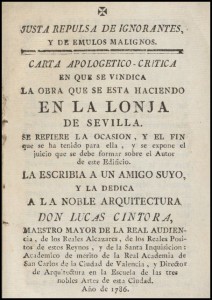
Book written by the architect Lucas Cintora defending his work at the Lonja de Sevilla which would later housed the new Archivo General de Sevilla.
“Until then I had thought each book spoke of the things, human or divine, that lie outside books. Now I realized that not infrequently books speak of books: it is as if they spoke among themselves. In the light of this reflection, the library seemed all the more disturbing to me. It was then the place of a long, centuries-old murmuring, an imperceptible dialogue between one parchment and another, a living thing, a receptacle of powers not to be ruled by a human mind, a treasure of secrets emanated by many minds, surviving the death of those who had produced them or had been their conveyors.” ― Umberto Eco, The Name of the Rose.
Today’s story is not about books talking about books necessarily but of a book talking about archives and their buildings, and the rationale, in this particular story, to evict people from a building to replace them with books and records in the name of history and imperial memory. In a way you can say that this is story of semiotics of archives, signs and meanings found in an article talking about a book talking about an archive to be born…
As I said in a previous post, it is valuable to hear from our researchers and to learn about how they used our archival materials in their work. Professor Daniel Nemser contacted me in April 2014 asking for access to one of our rare books titled, Justa repulsa de ignorantes y de émulos malignos: Carta apologético-crítica en que se vindica la obra que se está haciendo en la Lonja de Sevilla (1) written by the architect Lucas Cintora in 1786. Prof. Nemser needed to consult the piece for a scholarly article he was writing. As far as we know, there are two known copies in the world, one located at the University of Seville’s library and the other at the Archives and Special Collections here at UConn Storrs (2). Prof. Nemser was able to visit us last May 2014 to consult the book and last September 2015 he contacted me to let me know that his article, “Eviction and the archive: materials for an archaeology of the Archivo General de Indias” was published in Journal of Spanish Cultural Studies that month.
I was immediately intrigued and enchanted by the title of the article. It is not common to see literature scholars studying archives and their place in history. But this article delved into the history of the establishment of one of the most important archives ever created – an archive which documents “four centuries of Spanish colonial rule” and is considered the “first modern archives in Spain and one of the first in Europe” (page 131), el Archivo General de las Indias.
The article documented how a particular building known as La Casa Lonja de Mercaderes in Sevilla, designed by architect Juan de Herrera, a magnificent building to house the Consulado de Mercaderes (the city merchant guild), was repurposed to become the Archivo General de las Indias. After the construction “la Lonja”, the guild moved their office to the city of Cádiz and the building was abandoned, but right after people of poor means moved in and occupied the upper levels. The article explored how the founding of the archive, the eviction of its inhabitants and the modifications to the original building were part of an Enlightenment project by the Spanish crown to create a “modern archive” that justified their imperial project. Prof. Nemser explained that “the materiality of the archive itself would tell an epic tale about Spain’s colonial achievements and highlight the value of its ongoing colonial enterprise” (page 136).
The rare text from our collection was key to Prof. Nemser’s argument that the modifications of the original building by architect Lucas Cintora served to reshape the building’s functionality to conform to this enlightenment project. The modifications also represented a break with the past and the embrace of a new future, one that emphasized the importance of the Spanish empire and its validity to rule its colonies in the Americas. Prof. Nemser explained:
Since each type of building has a specific function and as such requires different formal characteristics, it will be necessary to “destroy” – Cintora does not pull his punches here – any elements of the original that are contrary to this new purpose. Of primary importance for an archive, he argued, was an open layout with what he called a “diaphanous” character. This was especially the case for an Enlightenment project such as the AGI [Archivo General de Indias], and as such it is understandable that the metaphor of light runs through much of the writing about the archive. In the structural transformation of the building, however, this metaphor takes on an architectural dimension: the need for light, clarity and transparency was precisely why the separation walls [inside the Lonja] had to be demolished (136).
As an archivist, it was fascinating to discover through the work of this scholar that Archives and Special Collections had a text in its collection that sheds light on the colonialistic root of the AGI. Prof. Nemser’s research left me pondering about the origins of other archival institutions, including our own. As Umberto Eco deftly explained in his novel The Name of the Rose, archives and libraries’ books are full of signs and meanings in constant dialogue with each others through the eyes of its readers.
We are honored and delighted to have facilitated Prof. Nemser’s research and to learn more about the complex history of archives.
Notes:
1: We recently digitized this book and now it is available at the Connecticut Digital Archive.
2: From the article, “According to Humanes Bustamante, 200 copies of Cintora’s book were printed but later withdrawn and destroyed (339n11). However, at least two copies remain. Zerner has analyzed a copy held at the AGI, while the copy I consulted is located at the Thomas J. Dodd Research Center at the University of Connecticut. I am grateful to Marisol Ramos for her assistance.”
Connecticut Children’s Book Fair 2015: This Weekend!
 Smiles, laughter, children’s books and their authors await you at the 24th Annual Connecticut Children’s Book Fair happening this Saturday, November 14 and Sunday, November 15 at the University of Connecticut. The fun begins at 10:00am. Check out this year’s exciting schedule of Authors and Illustrators featuring Ross MacDonald, Wendell Minor, Florence Minor, Cynthia Lord, P. J. Lynch, Jane Sutcliffe, Pamela Zagarenski, and Connecticut’s-own Barbara McClintock. Parking, directions, and links to local attractions, including the Ballard Museum of Puppetry, are available on the Book Fair website. Drop in to hear distinguished illustrators discuss their work, browse the latest releases, attend storytime and other events throughout the day including a visit by Clifford the Big Red Dog!
Smiles, laughter, children’s books and their authors await you at the 24th Annual Connecticut Children’s Book Fair happening this Saturday, November 14 and Sunday, November 15 at the University of Connecticut. The fun begins at 10:00am. Check out this year’s exciting schedule of Authors and Illustrators featuring Ross MacDonald, Wendell Minor, Florence Minor, Cynthia Lord, P. J. Lynch, Jane Sutcliffe, Pamela Zagarenski, and Connecticut’s-own Barbara McClintock. Parking, directions, and links to local attractions, including the Ballard Museum of Puppetry, are available on the Book Fair website. Drop in to hear distinguished illustrators discuss their work, browse the latest releases, attend storytime and other events throughout the day including a visit by Clifford the Big Red Dog!
The Connecticut Children’s Book Fair is a program of the University of Connecticut Libraries and the UConn Co-op. Proceeds from sales at the event are used for the growth of the Northeast Children’s Literature Collection in the Archives and Special Collections at the University of Connecticut Libraries.
Connecticut Children’s Book Fair 2015: This Weekend!
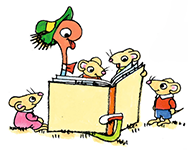 Smiles, laughter, children’s books and their authors await you at the 24th Annual Connecticut Children’s Book Fair happening this Saturday, November 14 and Sunday, November 15 at the University of Connecticut. The fun begins at 10:00am. Check out this year’s exciting schedule of Authors and Illustrators featuring Ross MacDonald, Wendell Minor, Florence Minor, Cynthia Lord, P. J. Lynch, Jane Sutcliffe, Pamela Zagarenski, and Connecticut’s-own Barbara McClintock. Parking, directions, and links to local attractions, including the Ballard Museum of Puppetry, are available on the Book Fair website. Drop in to hear distinguished illustrators discuss their work, browse the latest releases, attend storytime and other events throughout the day including a visit by Clifford the Big Red Dog!
Smiles, laughter, children’s books and their authors await you at the 24th Annual Connecticut Children’s Book Fair happening this Saturday, November 14 and Sunday, November 15 at the University of Connecticut. The fun begins at 10:00am. Check out this year’s exciting schedule of Authors and Illustrators featuring Ross MacDonald, Wendell Minor, Florence Minor, Cynthia Lord, P. J. Lynch, Jane Sutcliffe, Pamela Zagarenski, and Connecticut’s-own Barbara McClintock. Parking, directions, and links to local attractions, including the Ballard Museum of Puppetry, are available on the Book Fair website. Drop in to hear distinguished illustrators discuss their work, browse the latest releases, attend storytime and other events throughout the day including a visit by Clifford the Big Red Dog!
The Connecticut Children’s Book Fair is a program of the University of Connecticut Libraries and the UConn Co-op. Proceeds from sales at the event are used for the growth of the Northeast Children’s Literature Collection in the Archives and Special Collections at the University of Connecticut Libraries.
Armistice Day 1945 [70 Years After Nuremberg] | Human Rights Archives
 “This is Armistice Day–and I suppose a holiday at home. The first peace-time Armistice day in a long time. Here it is another day–another mark on the calendar.” [p. 192, 11/11/1945]
“This is Armistice Day–and I suppose a holiday at home. The first peace-time Armistice day in a long time. Here it is another day–another mark on the calendar.” [p. 192, 11/11/1945]
Tom Dodd spent the holiday working in an effort to “hasten these proceedings along” rather than sitting out in the cold watching two service teams play football. [p.192] The middle weeks of November saw regular clashes between General Donovan and Robert Jackson regarding the best way to present and try the case–Donovan preferring to emphasize witnesses and Jackson documents. Dodd felt caught in the middle. He liked both men and understood their individual perspectives while trying to stay out of the fray. Continue reading …
TONIGHT: The Story of Richard Scarry’s Busytown with Special Guest Lecturer Huck Scarry
Busytown, the bustling small town and home to such resident characters as Huckle Cat, Lowly Worm, Mr. Frumble, Police Sergeant Murphy, Mr. Fixit, and Hilda Hippo, was first depicted in the book Richard Scarry’s Busy, Busy World. The fictional town was a central feature in several Richard Scarry books and has been depicted through time in a variety of formats, including games, toys, activity books, and an animated series.
Richard Scarry, the popular and much-loved American author and illustrator of over 300 children’s books, is known for such classics as Richard Scarry’s Best Word Book Ever released in 1963, Richard Scarry’s Busy, Busy World(1965), Richard Scarry’s Storybook Dictionary (1966), and What Do People Do All Day (1968). Selling millions of copies 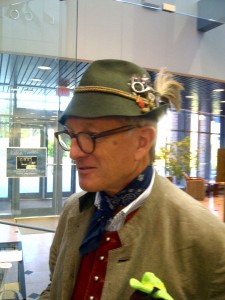 during his lifetime, many Scarry books, though regularly updated and re-issused, have never been out of print. Several have have been translated into over 20 languages.
during his lifetime, many Scarry books, though regularly updated and re-issused, have never been out of print. Several have have been translated into over 20 languages.
Join us tonight Tuesday November 10, 6:00pm for a special guest lecture “The Story of Richard Scarry’s Busytown” with Scarry’s son, Richard “Huck” Scarry II. Also an artist and author of children’s books, Huck Scarry published a new Scarry picture book for the first time in the U.S. since the elder Scarry’s death in 1994. With Richard Scarry’s Best Lowly Worm Book Ever! Huck Scarry began a season of re-releasing Scarry’s classics to commemorate the 50th anniversary of Richard Scarry’s best-known book, Richard Scarry’s Best Word Book Ever. Read more…
The Story of Richard Scarry’s Busytown with Special Guest Lecturer Huck Scarry
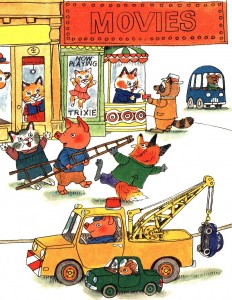 Busytown, the bustling small town and home to such resident characters as Huckle Cat, Lowly Worm, Mr. Frumble, Police Sergeant Murphy, Mr. Fixit, and Hilda Hippo, was first depicted in the book Richard Scarry’s Busy, Busy World. The fictional town was a central feature in several Richard Scarry books and has been depicted through time in a variety of formats, including games, toys, activity books, and an animated series.
Busytown, the bustling small town and home to such resident characters as Huckle Cat, Lowly Worm, Mr. Frumble, Police Sergeant Murphy, Mr. Fixit, and Hilda Hippo, was first depicted in the book Richard Scarry’s Busy, Busy World. The fictional town was a central feature in several Richard Scarry books and has been depicted through time in a variety of formats, including games, toys, activity books, and an animated series.
Richard Scarry, the popular and much-loved American author and illustrator of over 300 children’s books, is known for such classics as Richard Scarry’s Best Word Book Ever released in 1963, Richard Scarry’s Busy, Busy World (1965), Richard Scarry’s Storybook Dictionary (1966), and What Do People Do All Day (1968). Selling millions of copies during his lifetime, many Scarry books, though regularly updated and re-issused, have never been out of print. Several have have been translated into over 20 languages.
Join us tomorrow evening, Tuesday November 10, 6:00pm for a special guest lecture  “The Story of Richard Scarry’s Busytown” with Scarry’s son, Richard “Huck” Scarry II. Also an artist and author of children’s books, Huck Scarry published a new Scarry picture book for the first time in the U.S. since the elder Scarry’s death in 1994. With Richard Scarry’s Best Lowly Worm Book Ever! Huck Scarry began a season of re-releasing Scarry’s classics to commemorate the 50th anniversary of Richard Scarry’s best-known book, Richard Scarry’s Best Word Book Ever. The guest lecture event will take place in the Class of 1947 Room, Homer Babbidge Library, University of Connecticut in Storrs. The lecture is free and open to the public and is presented in conjunction with the 24th Annual Connecticut Children’s Book Fair taking place at UConn on Saturday and Sunday, November 14 and 15, 2015.
“The Story of Richard Scarry’s Busytown” with Scarry’s son, Richard “Huck” Scarry II. Also an artist and author of children’s books, Huck Scarry published a new Scarry picture book for the first time in the U.S. since the elder Scarry’s death in 1994. With Richard Scarry’s Best Lowly Worm Book Ever! Huck Scarry began a season of re-releasing Scarry’s classics to commemorate the 50th anniversary of Richard Scarry’s best-known book, Richard Scarry’s Best Word Book Ever. The guest lecture event will take place in the Class of 1947 Room, Homer Babbidge Library, University of Connecticut in Storrs. The lecture is free and open to the public and is presented in conjunction with the 24th Annual Connecticut Children’s Book Fair taking place at UConn on Saturday and Sunday, November 14 and 15, 2015.
Richard Scarry’s personal papers and archives, preserved and available in Archives and Special Collections at the Dodd Research Center, document the creation, production, and distribution of his books for children. The archives are part of the Northeast Children’s Literature Collection and contain materials and correspondence concerning Scarry’s early work, with Western Publishing and Little Golden Books, beginning in the 1950s. The bulk of the material in the archives concerns the works produced by Scarry during his later association with Random House.
Veteran’s Day, UConn style
More than 2000 UConn alumni served in World War II; 114 of them lost their lives in the conflict. After the war the Veteran’s Administration requested that the university accept between 3000 and 4000 returning soldiers as students. In 1946 the campus had 792 veterans enrolled as students (11 of them were women) with another 300 at the Hartford and Waterbury extension campuses and 154 are enrolled in the Law, Insurance and Pharmacy schools. Eleven temporary barracks, nicknamed “Siberia” because of their distance from the main campus, were built on “the site of the former agronomy plots bordering the main road to Willimantic.” This site is now the Fine Arts Complex and E.O. Smith High School. As more veterans were accepted to UConn more housing was built or found in nearby Willimantic.


